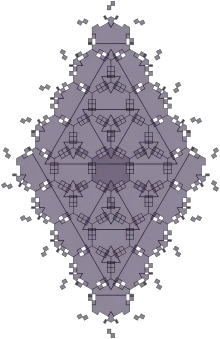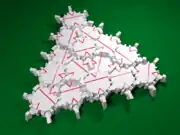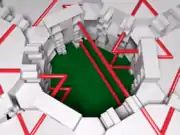
The Socolar–Taylor tile is a single non-connected tile which is aperiodic on the Euclidean plane, meaning that it admits only non-periodic tilings of the plane (due to the Sierpinski's triangle-like tiling that occurs), with rotations and reflections of the tile allowed.[1] It is the first known example of a single aperiodic tile, or "einstein".[2] The basic version of the tile is a simple hexagon, with printed designs to enforce a local matching rule, regarding how the tiles may be placed.[3] It is currently unknown whether this rule may be geometrically implemented in two dimensions while keeping the tile a connected set.[2][3]
This is, however, confirmed to be possible in three dimensions, and, in their original paper, Socolar and Taylor suggest a three-dimensional analogue to the monotile.[1] Taylor and Socolar remark that the 3D monotile aperiodically tiles three-dimensional space. However the tile does allow tilings with a period, shifting one (non-periodic) two dimensional layer to the next, and so the tile is only "weakly aperiodic".
Physical copies of the three-dimensional tile could not be fitted together without allowing reflections, which would require access to four-dimensional space.[2][4]
Gallery
 The monotile implemented geometrically. Black lines are included to show how the structure is enforced.
The monotile implemented geometrically. Black lines are included to show how the structure is enforced. A three-dimensional analogue of the Socolar-Taylor tile (all matching rules implemented geometrically)
A three-dimensional analogue of the Socolar-Taylor tile (all matching rules implemented geometrically)
 A three-dimensional analogue of the monotile, with matching rules implemented geometrically. Red lines are included only to illuminate the structure of the tiling. Note that this shape remains a connected set.
A three-dimensional analogue of the monotile, with matching rules implemented geometrically. Red lines are included only to illuminate the structure of the tiling. Note that this shape remains a connected set. A partial tiling of three-dimensional space with the 3D monotile.
A partial tiling of three-dimensional space with the 3D monotile. A tiling of 3D space with one tile removed to demonstrate the structure.
A tiling of 3D space with one tile removed to demonstrate the structure.
References
- 1 2 Socolar, Joshua E. S.; Taylor, Joan M. (2011), "An aperiodic hexagonal tile", Journal of Combinatorial Theory, Series A, 118 (8): 2207–2231, arXiv:1003.4279, doi:10.1016/j.jcta.2011.05.001, MR 2834173.
- 1 2 3 Socolar, Joshua E. S.; Taylor, Joan M. (2012), "Forcing nonperiodicity with a single tile", The Mathematical Intelligencer, 34 (1): 18–28, arXiv:1009.1419, doi:10.1007/s00283-011-9255-y, MR 2902144
- 1 2 Frettlöh, Dirk. "Hexagonal aperiodic monotile". Tilings Encyclopedia. Retrieved 3 June 2013.
- ↑ Harriss, Edmund. "Socolar and Taylor's Aperiodic Tile". Maxwell's Demon. Retrieved 3 June 2013.

